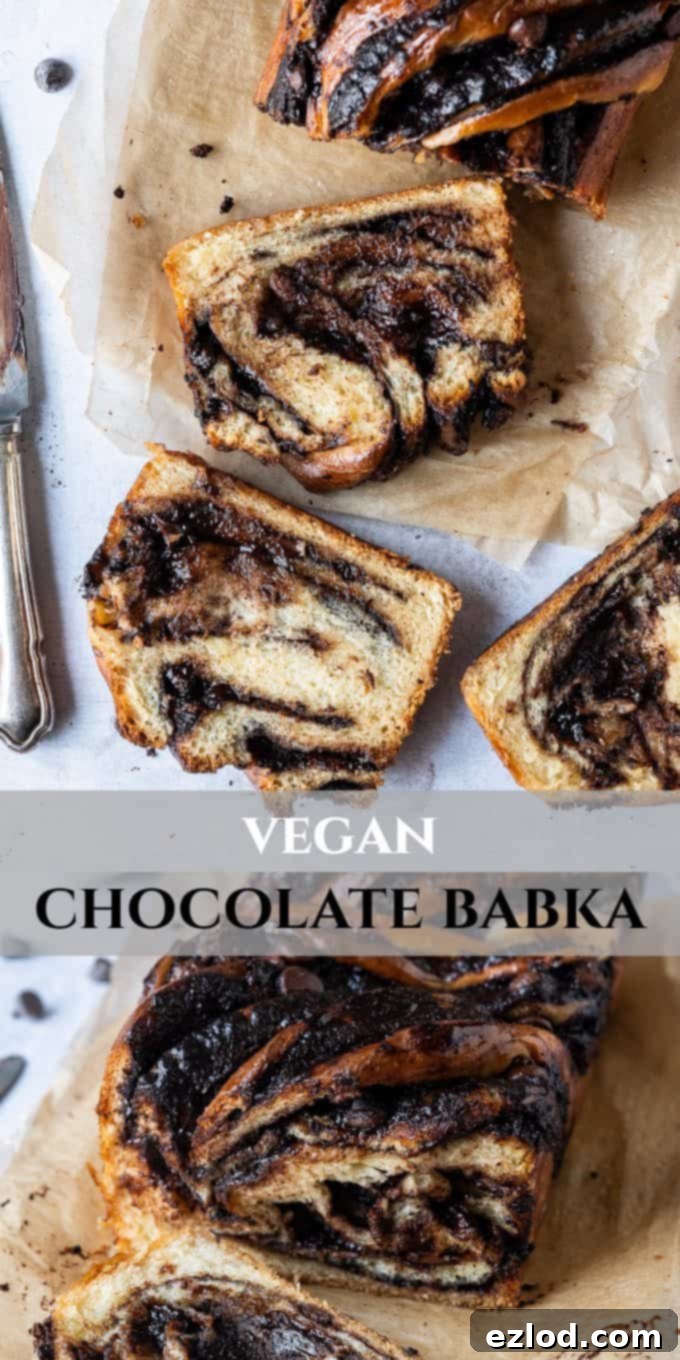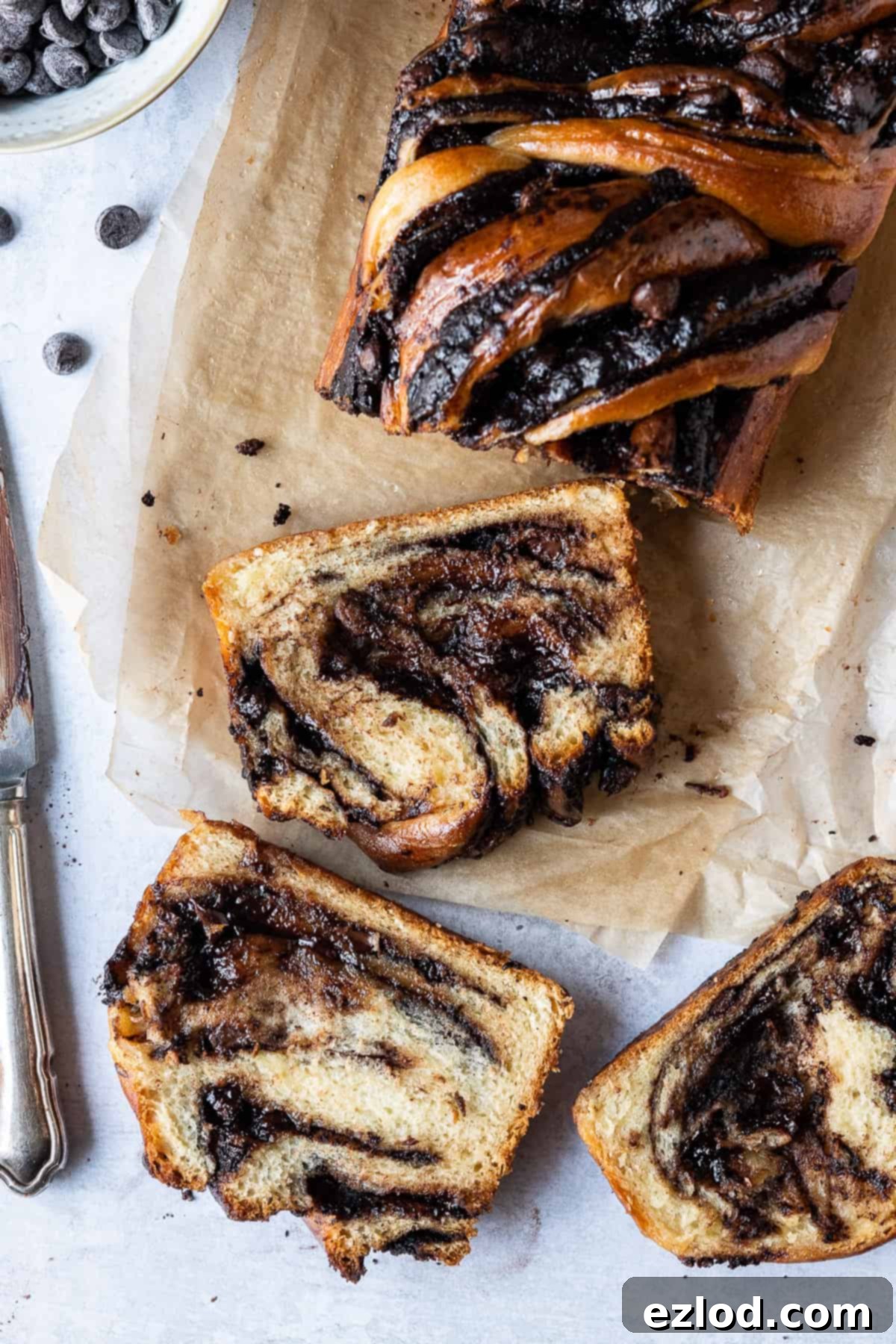Irresistible Vegan Chocolate Babka: A Decadent Swirl Bread Recipe
Discover the magic of homemade vegan chocolate babka – a truly amazing vegan chocolate swirl bread that boasts a luxuriously soft, brioche-like dough, generously swirled with a rich, intense chocolate filling, and finally soaked in a sweet, shimmering syrup. The result is an incredibly tender, moist, and deeply chocolatey treat that is utterly moreish and guaranteed to become a household favorite! Best of all, this recipe achieves its incredible texture and flavor without any egg replacers or unusual, hard-to-find ingredients.
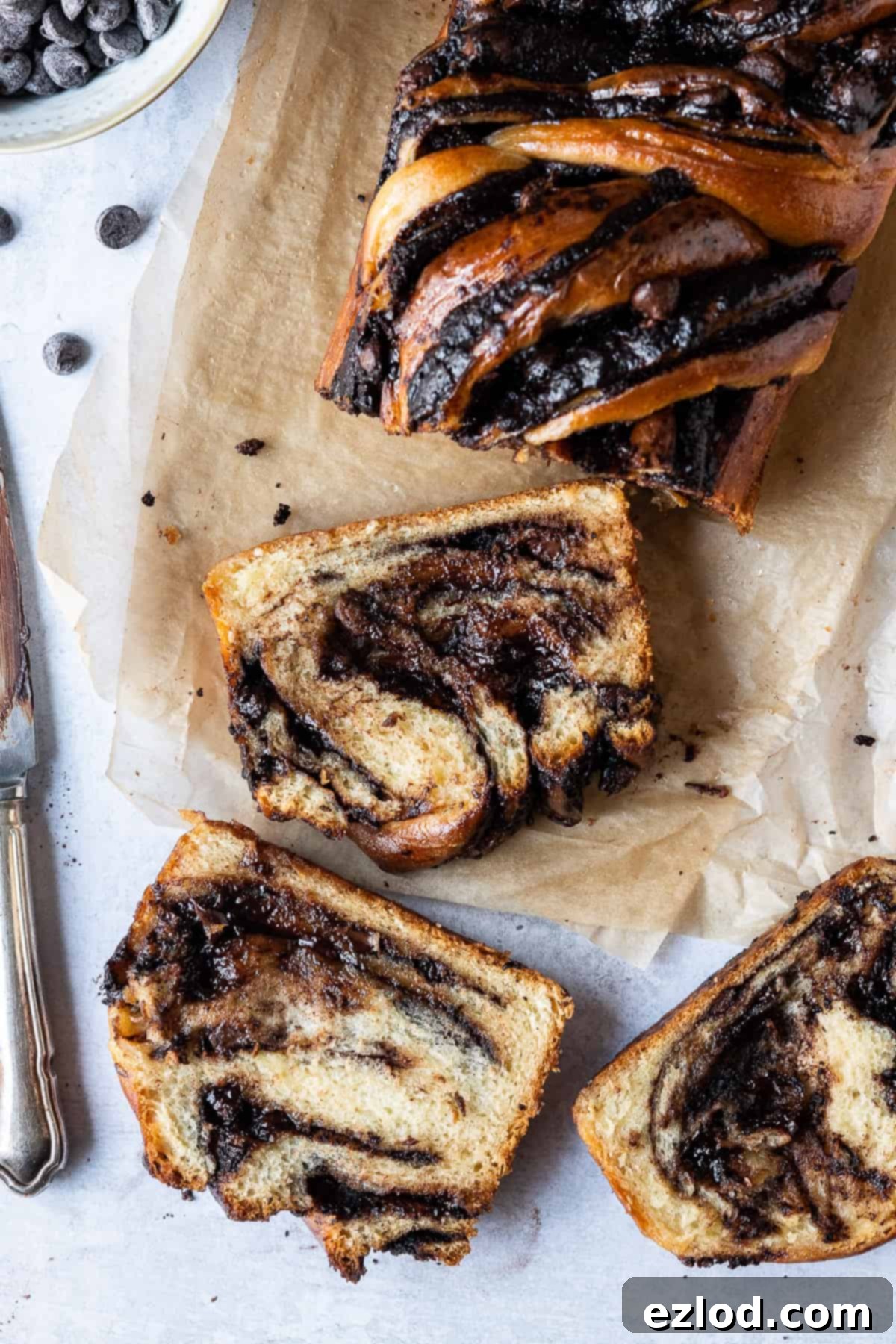
This vegan chocolate babka is more than just a baked good; it’s a truly indulgent experience. Imagine a soft, pillowy bread dough, completely eggless and dairy-free, yet possessing all the richness and tender crumb of a traditional brioche. This delightful dough is then lovingly spread with a thick, luxurious layer of decadent chocolate filling. But why stop there? We’ve taken it a step further by adding extra chocolate chips throughout, because when it comes to chocolate, more is always better, right?
The journey to babka perfection doesn’t end with baking. Once out of the oven, this braided beauty is generously brushed with a simple yet transformative sugar syrup. This syrup not only imparts a gorgeous, glistening shine to the babka’s crust but also plays a crucial role in maintaining its exquisite moisture. This ensures that your babka remains wonderfully soft and fresh for several days, making it an ideal treat to savor or share.
It’s an utterly delicious and truly indulgent creation, making it the perfect companion for a quiet morning cup of tea or a robust coffee. Whether you’re a seasoned vegan baker or simply looking to impress with a show-stopping dessert, this babka is sure to delight.
While the process of making babka might seem a little lengthy, please don’t be intimidated. It’s not inherently difficult, and much of the time involved is “hands-off,” dedicated to allowing the dough to rise and develop its incredible flavor and texture. For the absolute best results and an easier baking experience, I highly recommend spreading the preparation over two days. This involves making the dough on the first day and allowing it to undergo a slow, cold rise overnight in the refrigerator. The following day, you’ll simply shape the babka, give it a final rise, and then bake it to golden perfection. This two-day approach significantly enhances the flavor of the dough and firms it up, making it much easier to handle, roll out, and shape into its characteristic braid.
Of course, if your schedule demands it, it’s entirely possible to complete the entire process in a single day. However, the extended overnight fermentation in the fridge contributes immensely to the depth of flavor, creating a more complex and nuanced taste that truly sets it apart. It also improves the dough’s workability, leading to a smoother, more successful shaping process.
What Exactly Is Babka? Unraveling the History of This Beloved Sweet Bread:
Babka is a sweet, cake-like braided yeast bread with a rich history, tracing its origins to the Jewish communities of Eastern Europe, particularly Poland, in the early 19th century. The name “babka” itself is thought to come from the Polish word “babcia,” meaning grandmother, possibly referring to its tall, pleated shape reminiscent of a grandmother’s skirt. It’s sometimes also known as a krantz cake, particularly in some Ashkenazi Jewish traditions.
At its heart, babka typically consists of a soft, enriched dough, often likened to a brioche due to its high fat content, which contributes to its tenderness. This dough is meticulously rolled out into a thin sheet and generously spread with a flavorful filling. While chocolate is arguably the most popular and iconic filling today, traditional babka also frequently features cinnamon, sweet cheese, or various fruit preserves. After the filling is applied, the dough is rolled up into a log, sliced lengthwise, and then artfully twisted or braided before being baked. The result is a stunning cross-section of dough and filling, creating those signature swirls that are as beautiful as they are delicious.
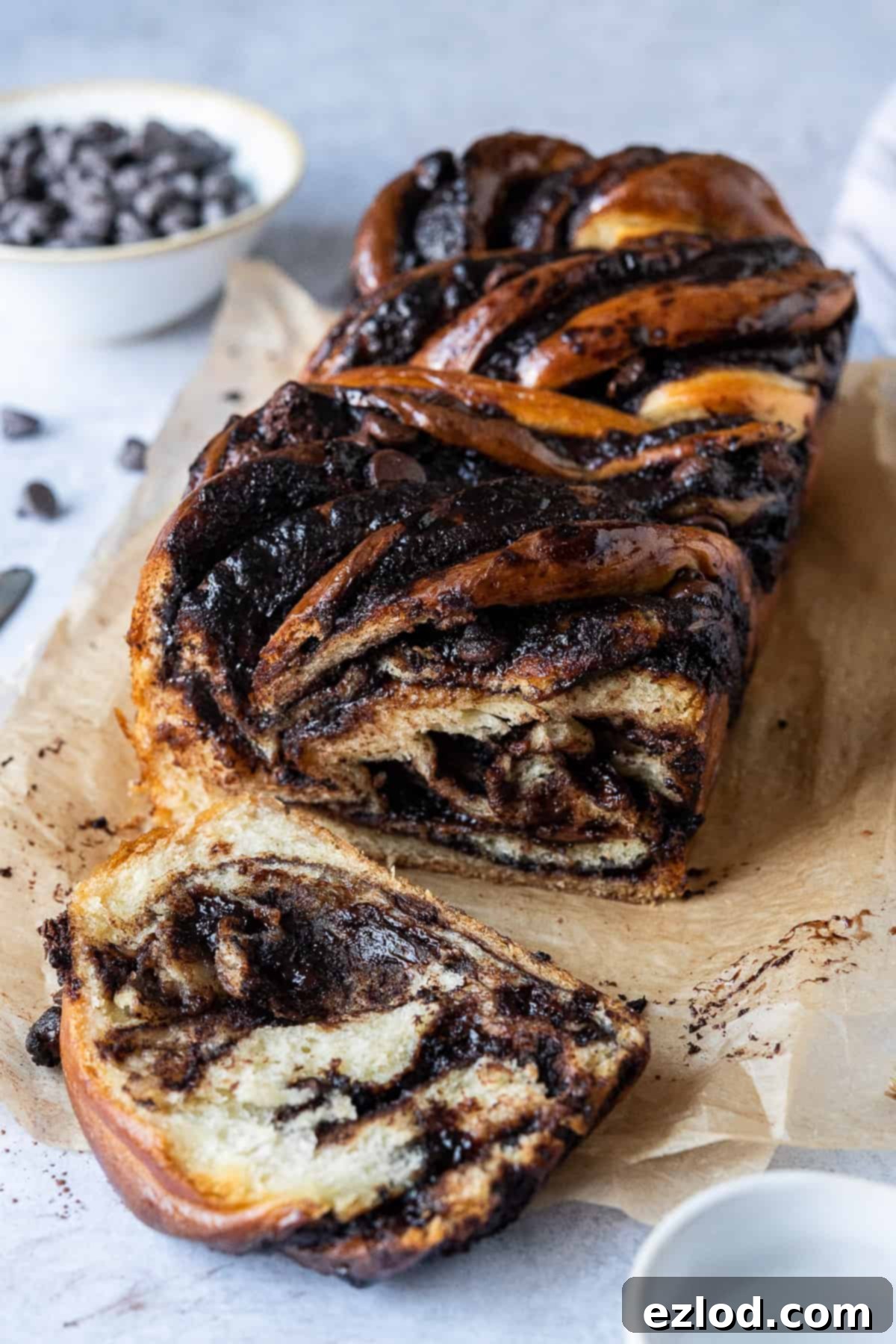
How To Craft Your Own Vegan Chocolate Babka: A Step-by-Step Guide
(For a complete list of ingredients with precise measurements and detailed instructions, please refer to the comprehensive recipe card located further down.)
To truly achieve the best flavor and texture, I highly recommend beginning the babka preparation the day before you plan to bake it. Start by combining your dry ingredients: measure the all-purpose or bread flour, sugar, instant yeast, and salt into a large mixing bowl. If you’re fortunate enough to own a stand mixer, this is the perfect time to attach its dough hook and let it do the hard work for you. Give these dry ingredients a quick mix to ensure they are thoroughly combined.
Next, pour in the lukewarm non-dairy milk (soy milk is often recommended for its richness, but oat or almond milk can also work). Mix these components together until a rough, shaggy dough begins to form. Continue kneading the dough until it comes together into a relatively smooth ball, at which point it’s ready for the next crucial addition.
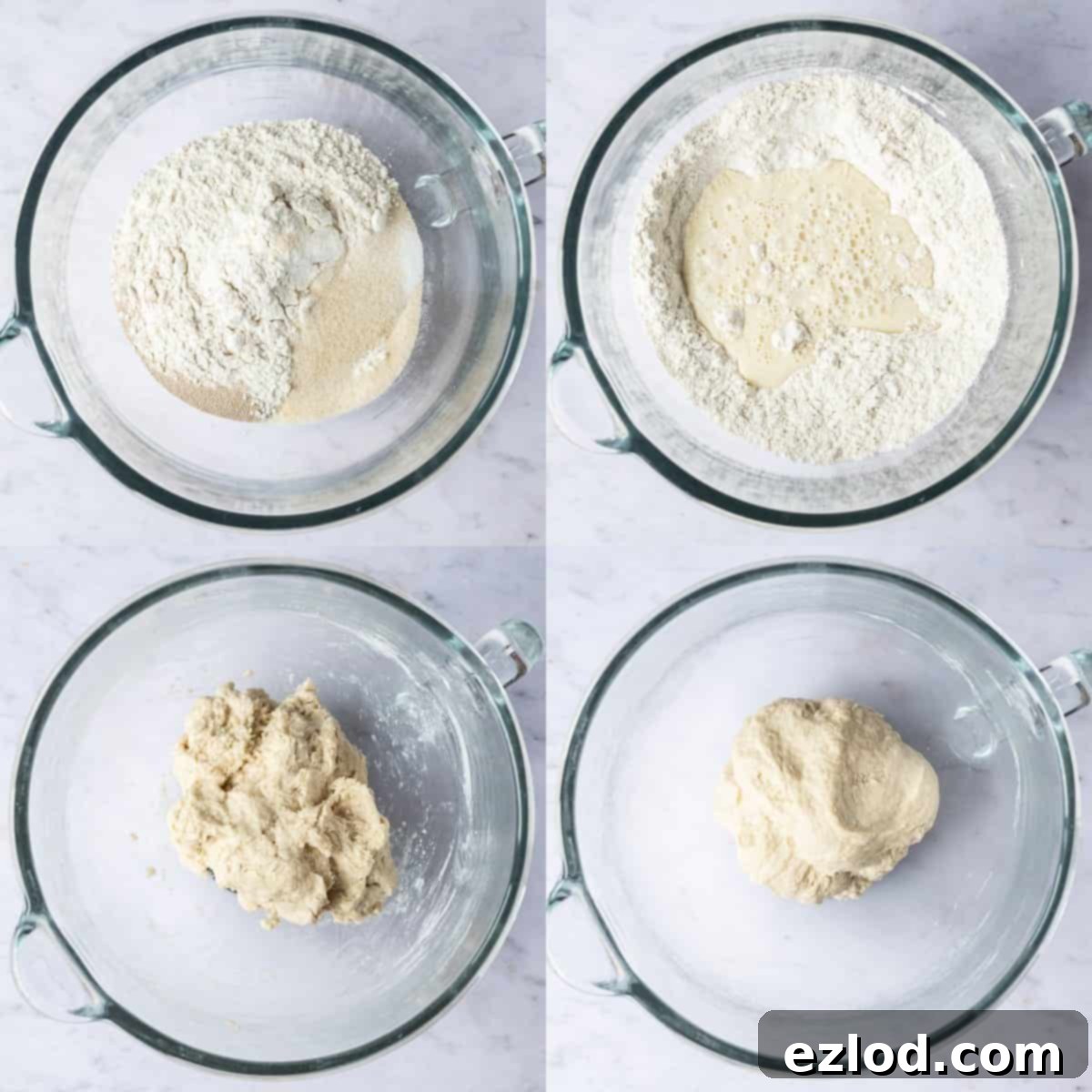
Now, introduce the softened vegan butter into the dough. This is where patience is key. Continue to knead the dough, either by hand or with your stand mixer, until the butter is completely incorporated. At first, the dough may appear greasy, messy, and even a little fragmented, but trust the process. Keep kneading! I promise that with persistent mixing, the butter will eventually be fully absorbed, transforming the dough into a beautifully smooth, pliable, and elastic ball. The kneading process is essential for developing the gluten structure, which gives babka its characteristic chewy yet tender texture.
Once the vegan butter has been fully incorporated, the dough should have a noticeably smooth and silky appearance. When touched, it should pull away cleanly from the sides of your mixing bowl. While it should still feel soft and slightly tacky to the touch, it shouldn’t be overly wet or sticky. If you find your dough to be excessively wet, you can carefully knead in a very small amount of additional flour, a teaspoon at a time. Be extremely cautious not to add too much, as an excess of flour can lead to a dry, dense babka, which is definitely what we want to avoid!
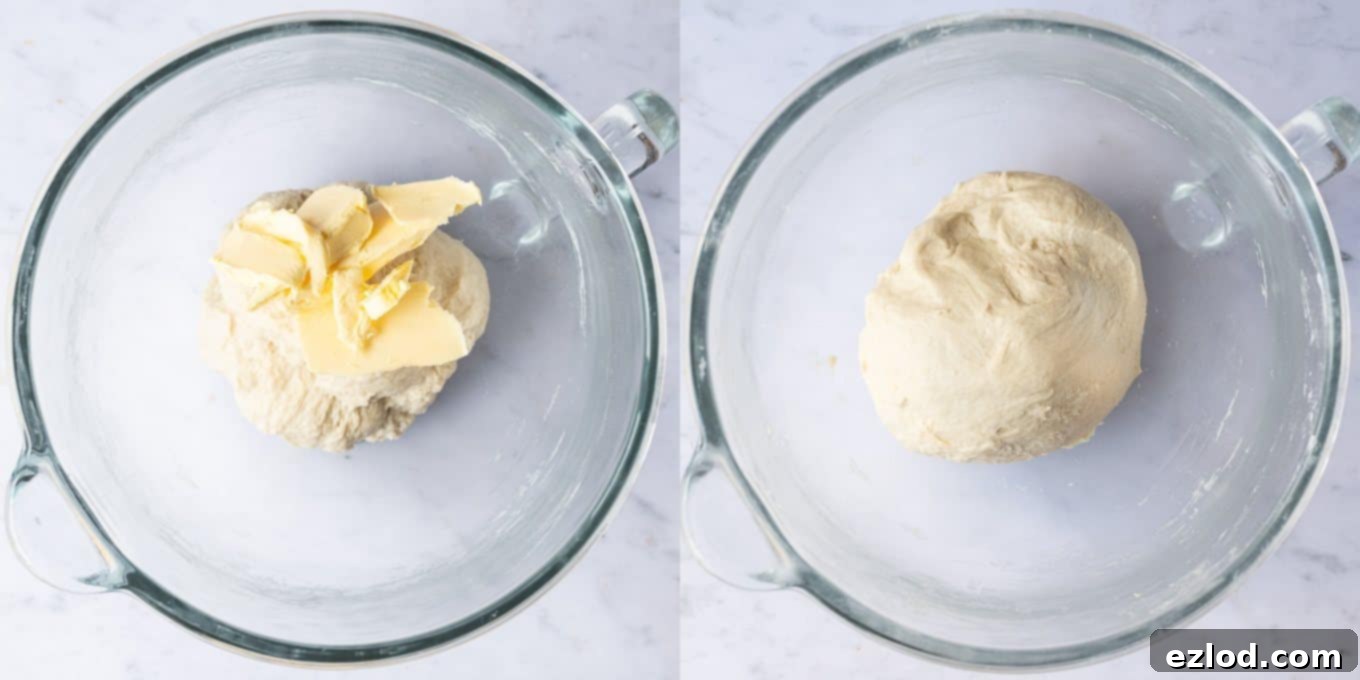
Once your dough reaches this perfect consistency, transfer it to a lightly oiled bowl. Turn the dough once to ensure it’s coated with a thin layer of oil, which prevents it from sticking. Cover the bowl tightly with plastic wrap or a clean kitchen towel and place it in the refrigerator to undergo a slow, overnight rise. This cold fermentation is not just for convenience; it allows the flavors to deepen and the gluten to relax, resulting in a more flavorful and easier-to-handle dough.
The following day, you’ll be greeted by a dough that has beautifully doubled in size after its long rest. Remove the bowl from the fridge and set it aside at room temperature to warm up slightly while you prepare the rich, luscious chocolate filling. Allowing the dough to come closer to room temperature makes it more elastic and easier to roll out.
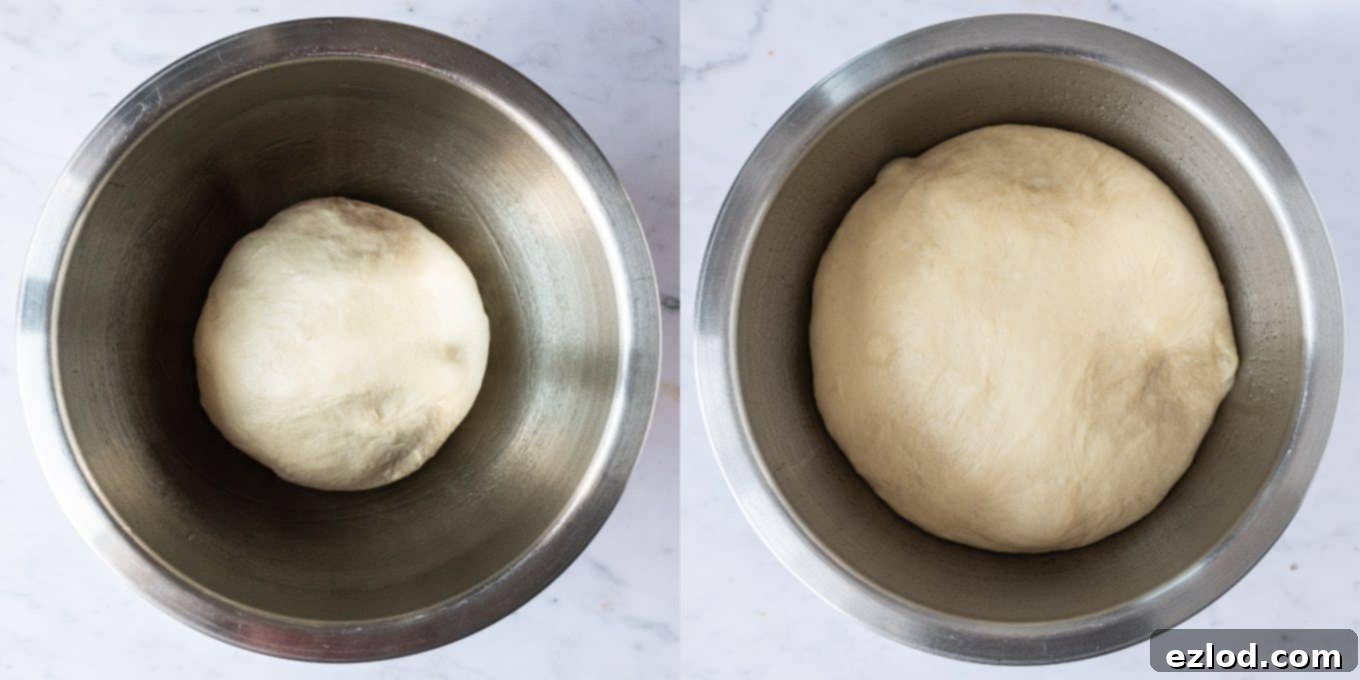
Now, let’s create the star of the show: the decadent chocolate filling. In a small saucepan, combine the vegan butter, finely chopped dark chocolate, sugar, cocoa powder, a hint of cinnamon (which beautifully complements the chocolate, though it’s optional), and a tiny pinch of salt to enhance the flavors. Place this saucepan over a very low heat, stirring constantly to prevent scorching. Continue stirring until all the ingredients have fully melted and you have a smooth, glossy chocolate mixture. Immediately remove the pan from the heat and set it aside to cool for about 20 minutes. During this cooling period, the filling will thicken slightly to a perfectly spreadable consistency. If, by any chance, it becomes too firm, a gentle rewarming over low heat will quickly bring it back to that ideal spreadable state.
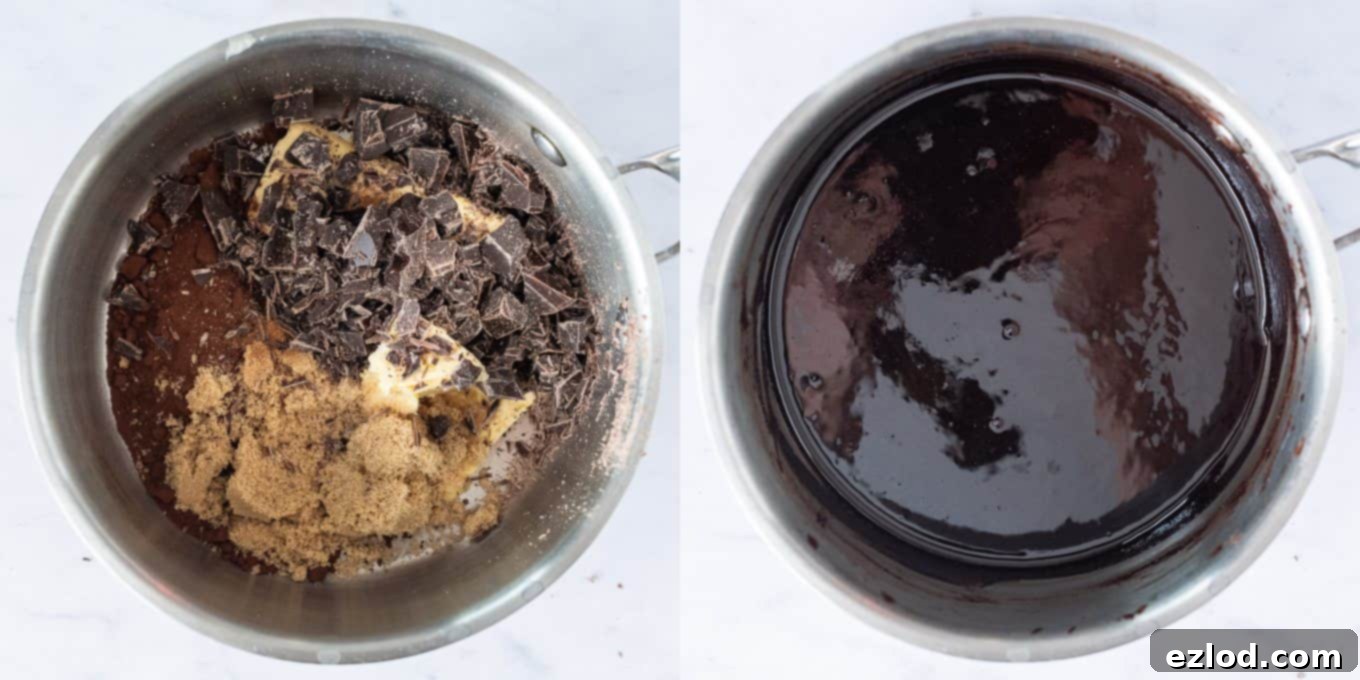
Mastering the Art of Shaping Vegan Chocolate Babka:
With your dough rested and your filling cooled, it’s time for the most visually rewarding part: shaping the babka. Gently “punch down” the risen dough to release the accumulated gases, then transfer it to a lightly floured surface. Using a rolling pin, roll the dough out into a neat rectangle, aiming for approximate dimensions of 30x40cm (or about 11×15 inches). Strive for an even thickness across the entire rectangle to ensure uniform layers in your final babka.
Carefully spread the prepared chocolate filling evenly over the rolled-out dough, making sure to leave a small 1cm (approximately ½ inch) border along all edges. This border will help seal the dough when you roll it up. Now for the extra touch of chocolatey goodness: generously sprinkle your chosen additions – be it chocolate chips, more chopped dark chocolate, or even toasted pecans for a textural contrast – over the chocolate filling. Gently press them down so they adhere to the filling.
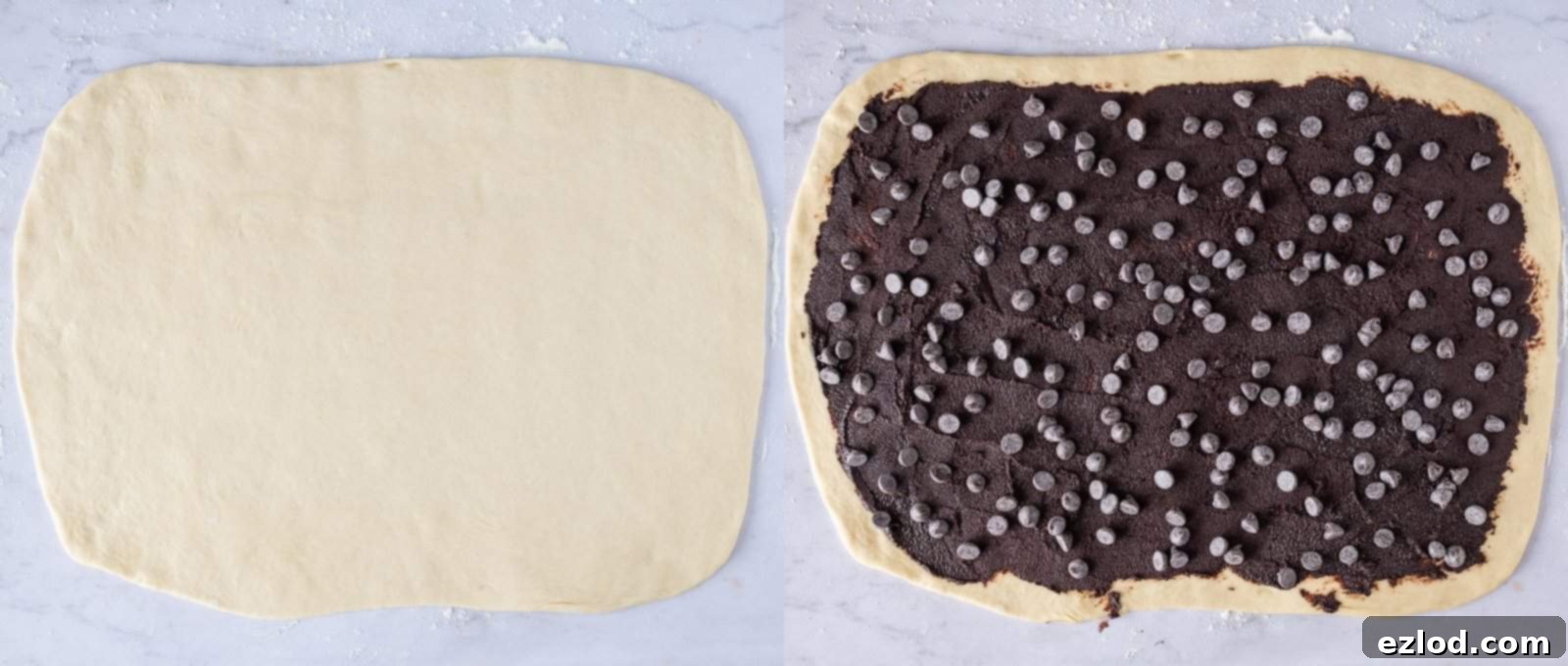
Starting from one of the long edges, carefully and tightly roll the dough into a snug sausage shape. Ensure it’s rolled as tightly as possible to create those beautiful, distinct swirls. Once you have a firm log, use a very sharp knife (a serrated knife can work well here) to carefully cut the “sausage” in half lengthwise, from one end to the other. This action will expose the vibrant layers of chocolate filling within the dough, which is crucial for the babka’s iconic appearance. With the two halves now separated, gently twist them together, forming an elegant braid. This technique showcases the stunning chocolate swirls that run through the bread.
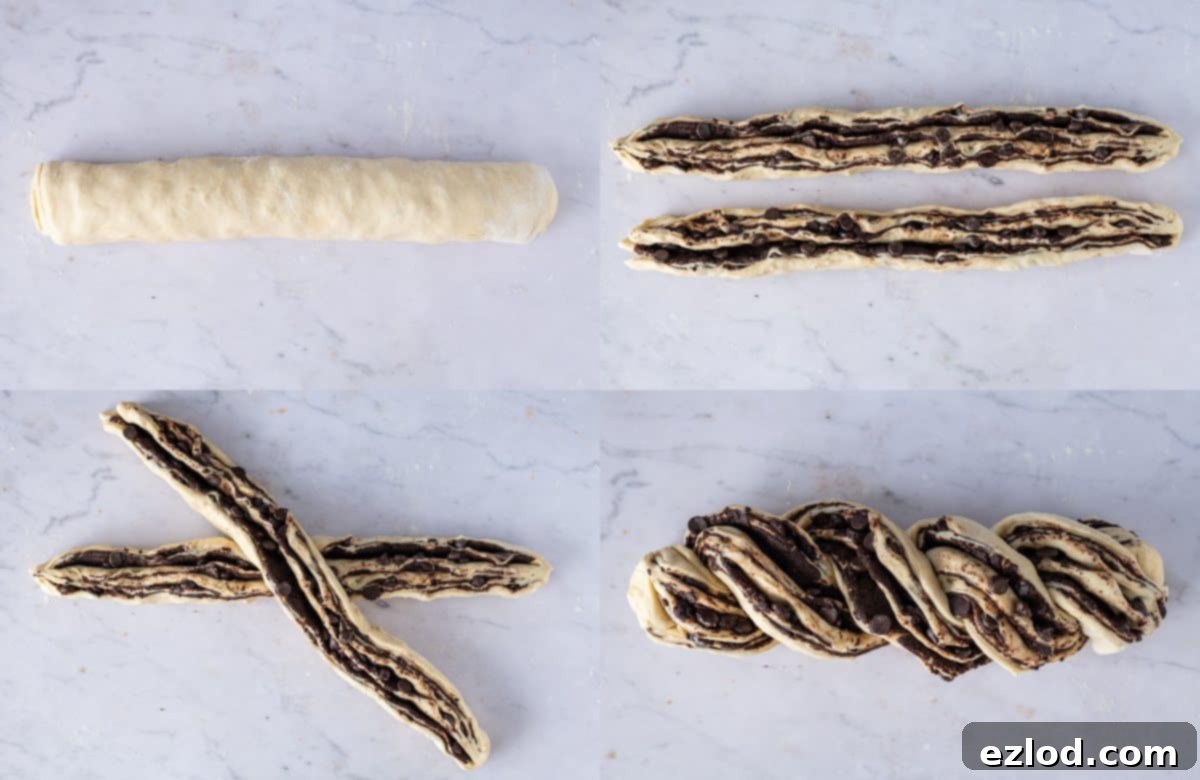
Prepare your loaf tin by greasing an approximate 11.5 x 21.5 cm (4.5 x 8.5 inch) 2lb loaf tin and lining it with baking parchment, allowing the parchment to overhang slightly on the long sides for easy removal later. Carefully transfer your beautifully braided babka into the prepared loaf tin. Don’t hesitate to gently squish and adjust it to fit perfectly within the tin if necessary – the dough is forgiving. Loosely cover the tin with plastic wrap or a clean kitchen towel and set it aside in a warm place for its final proofing. Allow it to rise until it has visibly doubled in size, which typically takes about 1 ½ to 2 hours, though this can vary depending on the ambient temperature of your kitchen. You’ll know it’s ready when it looks wonderfully puffy, and if you gently press a finger into a small, exposed portion of the dough, it springs back slowly most of the way but leaves a slight indentation. If it springs back immediately and completely, it needs a little more time to rise.
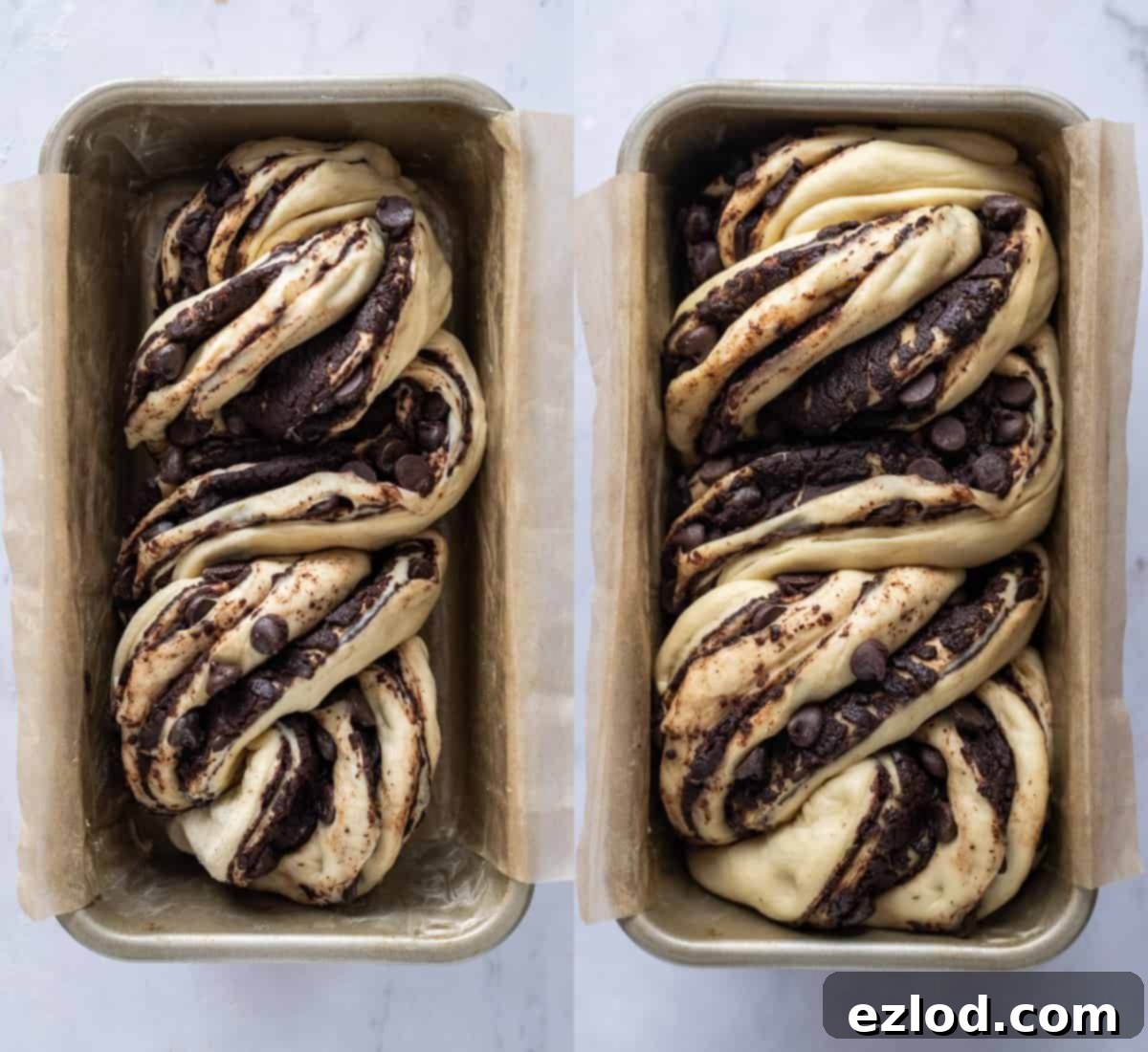
Once your babka has completed its final rise and the oven is preheated, it’s time to bake! Place the tin in the preheated oven and bake for approximately 35-40 minutes. The babka should emerge with a deep, golden-brown crust. For absolute certainty that it’s perfectly cooked through, insert a probe thermometer into the center of the loaf; it should register a temperature of about 90°C (195°F). This internal temperature ensures the dough is fully cooked and safe to eat.
As soon as the babka is out of the oven, brush it generously with the prepared sugar syrup while it’s still hot. This allows the syrup to soak deep into the warm bread, locking in moisture and adding that characteristic shine. Allow it to cool almost completely before attempting to slice it, as slicing too soon can compress the delicate crumb.
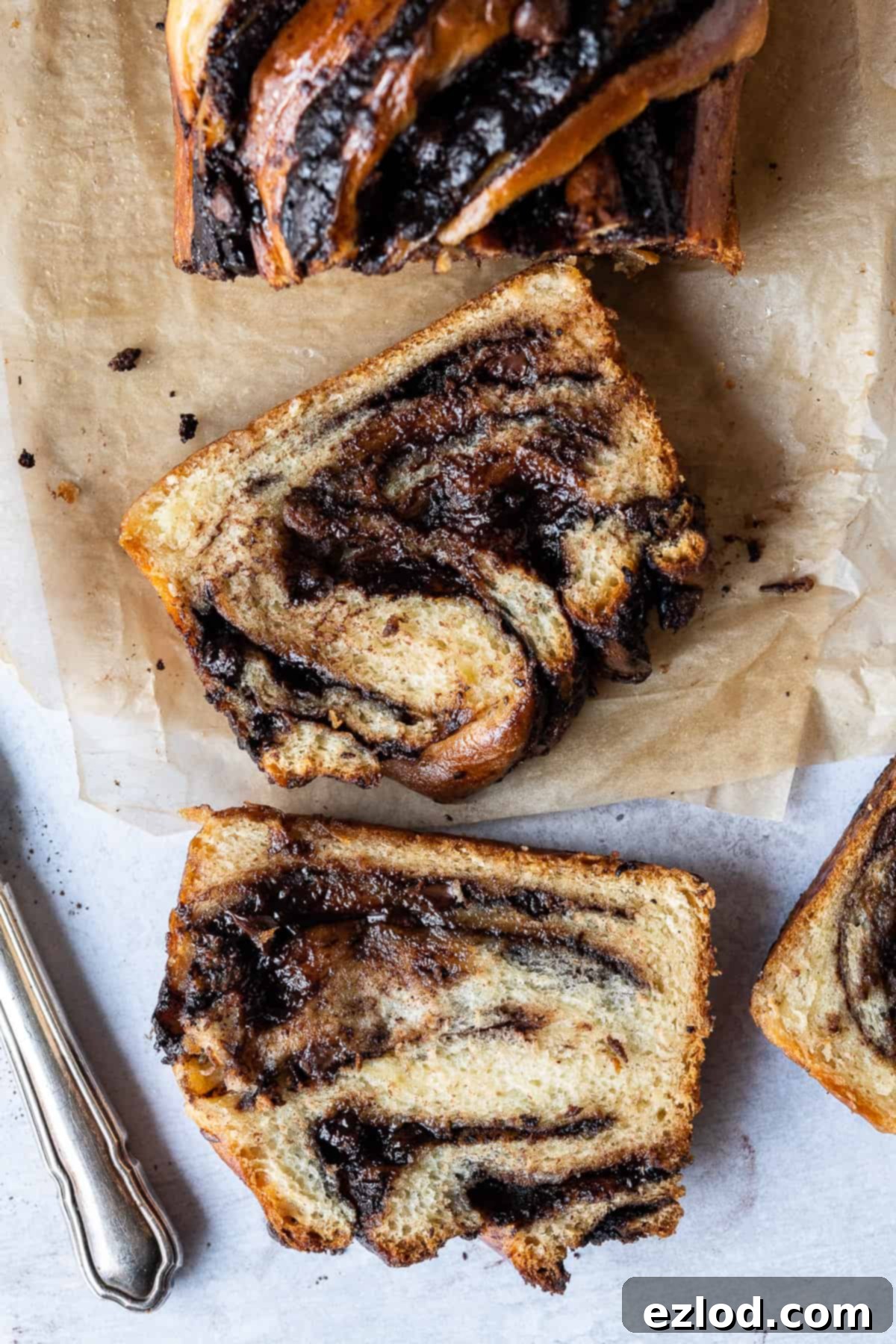
Expert Tips for Baking the Perfect Vegan Chocolate Babka Every Time:
Achieving a show-stopping babka consistently comes down to a few key details. For the very best results, it’s crucial that you follow this recipe closely, paying attention to the nuances. As always in baking, I cannot stress enough the importance of using gram measurements with a digital kitchen scale, rather than relying on cup conversions. Cup measurements are simply not precise enough for baking, and I cannot guarantee the best outcome if they are used.
When it comes to flour, you have a couple of good options. You can use either plain (all-purpose) flour or white bread flour. Bread flour, with its higher protein content, will contribute to a slightly chewier, more substantial texture in your babka. However, plain flour also yields excellent results, producing a tender crumb. You can even use a combination of the two for a balanced texture, perhaps 50/50.
Do not be tempted to skip the syrup! It might seem like a lot of liquid to brush onto a freshly baked loaf, but this step is absolutely vital. The syrup is what gives the babka its beautiful glossy finish and, more importantly, it infuses moisture into the bread, helping to keep it wonderfully soft and fresh for several days. Trust me on this one – use all of it!
The most reliable method for determining if any loaf of bread, including your babka, is fully cooked in the center is to use a probe thermometer. Baking times are always approximate because oven temperatures can vary significantly. Your babka is perfectly done when a thermometer inserted into its deepest part reaches an internal temperature of 90°C (195°F).
I know, the aroma will be intoxicating, and the temptation to slice into your warm babka immediately will be almost unbearable, but you truly must wait! Allow the babka to cool completely before you slice into it. Bread continues to “cook” internally as it cools, and slicing it too soon can result in a dense, gummy, or doughy texture instead of the light, tender crumb you’ve worked so hard to achieve.
Understanding Yeast: What Type to Use for Your Babka:
For convenience and consistent results, I typically use fast-action yeast, which is also widely known as instant yeast or easy-blend yeast. The beauty of this type of yeast is that it doesn’t require any prior activation; you can simply add it directly to your dry flour mixture, making the process very straightforward.
However, if your pantry only holds active dried yeast, you can absolutely still use it for this recipe. The key difference is that active dried yeast needs to be “proofed” or activated before it’s combined with the rest of your ingredients. To do this, mix the active dried yeast with a portion of the warm non-dairy milk and a tiny pinch of the sugar specified in the recipe. Let this mixture sit undisturbed for about 10-20 minutes. You’ll know it’s ready when the surface becomes foamy and bubbly, indicating that the yeast is active and alive. Once proofed, you can proceed with the rest of the recipe as written, adding the activated yeast mixture when the recipe calls for lukewarm milk.
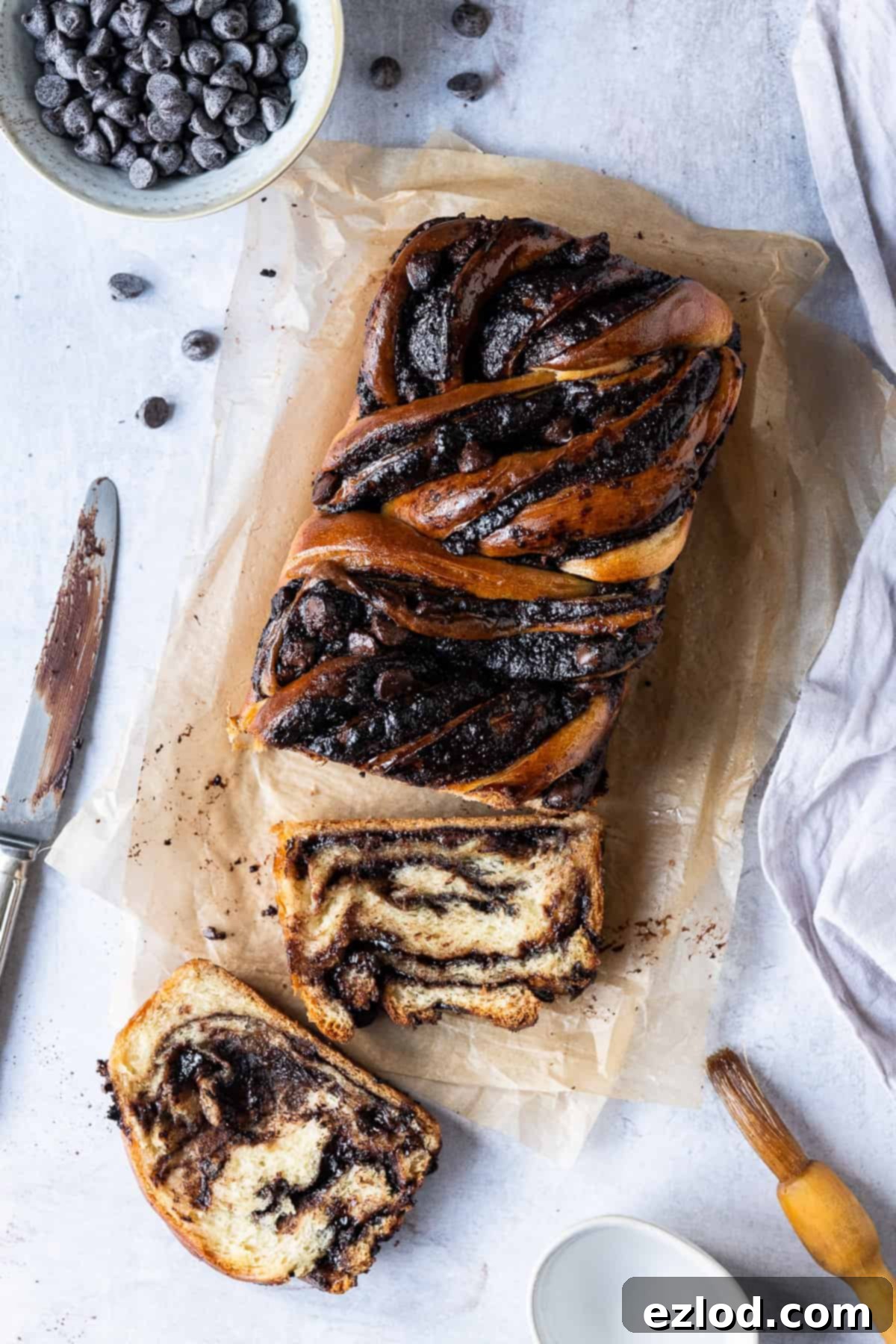
Storage Best Practices for Your Vegan Chocolate Babka:
As is true for most homemade bread, this vegan chocolate babka is at its absolute best when enjoyed on the day it is baked. However, thanks to the generous application of syrup, it maintains its delightful moisture and softness for approximately 3 days. If you’re enjoying it on subsequent days, a gentle warming in the oven or microwave before serving can help refresh it and bring back some of that freshly baked magic.
To keep your babka fresh, store it in an airtight container or a dedicated bread bin at room temperature. It’s important to avoid storing it in the refrigerator, as the cold environment can actually cause bread to go stale faster, drying out its tender crumb.
Can Vegan Chocolate Babka Be Frozen for Future Enjoyment?:
Absolutely! This vegan chocolate babka freezes exceptionally well, allowing you to savor its deliciousness long after baking. You can freeze it either as a whole loaf or conveniently sliced into individual portions. To ensure maximum freshness, it’s best to freeze the babka on the same day it’s baked, once it has cooled completely. Wrap it tightly in plastic wrap, then place it in a ziplock bag or an airtight freezer-safe container. It will keep beautifully in the freezer for up to three months.
When you’re ready to enjoy it, simply allow the babka to defrost at room temperature. For an extra special treat, gently warm the defrosted babka in a preheated oven (around 160°C/325°F for 10-15 minutes) or a microwave before serving. This will restore its soft texture and warm the chocolate filling, making it taste almost as good as fresh out of the oven.
Explore More Delicious Vegan Bread Recipes:
If you’ve loved baking this vegan chocolate babka, you might enjoy trying some of these other fantastic vegan bread creations:
- Vegan Hokkaido Milk Bread – Incredibly soft and fluffy, perfect for sandwiches or toast.
- Vegan Challah Bread – A beautiful braided loaf, wonderful for Shabbat or any occasion.
- Gingerbread Cinnamon Rolls – A festive twist on a classic, spiced and sweet.
- Vegan Hot Cross Buns – Traditional, spiced buns perfect for spring.
- Vegan Brioche – The ultimate rich and tender vegan bread.
- Banana Bread Cinnamon Rolls – A delightful fusion of two beloved baked goods.
- Pumpkin Bread Rolls – Soft, savory-sweet rolls with a hint of autumn.
- Vegan Lemon Blueberry Rolls – Bright and zesty, a refreshing sweet treat.
- Maple Pecan Bread Wreath – A stunning and flavorful centerpiece.
- Vegan Wholemeal Maple Cinnamon Rolls – A wholesome and cozy breakfast or dessert.
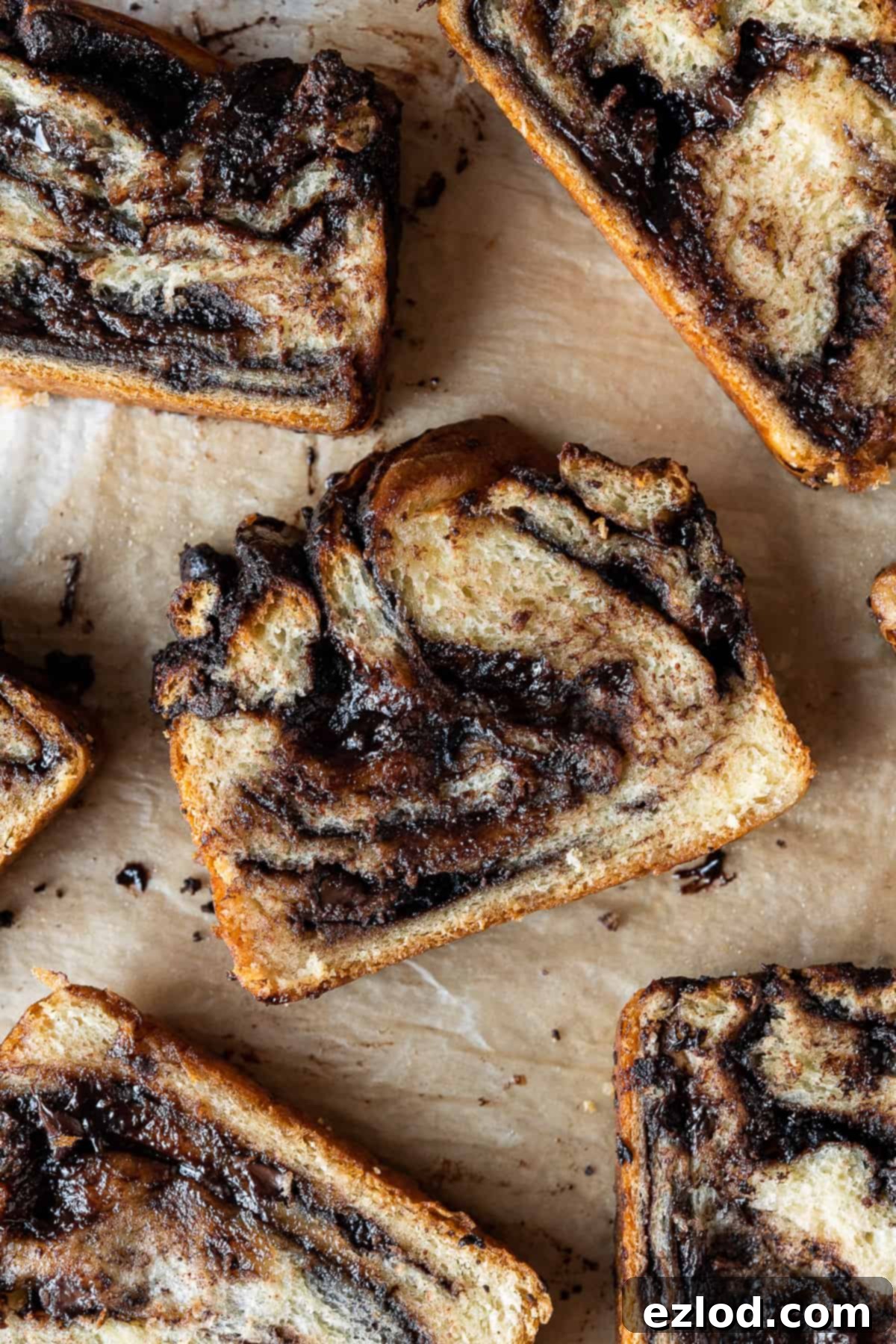
If you’ve had the pleasure of trying this exquisite vegan chocolate babka recipe, we’d absolutely love to see your creations! Please share your photos on Instagram and tag @domestic_gothess, and don’t forget to use the hashtag #domesticgothess so we can admire your beautiful babkas!
*Please Note: All images and written content on Domestic Gothess are protected by copyright. If you wish to share this recipe with others, kindly do so by utilizing the provided share buttons on the page. We respectfully request that you do not screenshot or repost the full recipe or content directly on other platforms.*
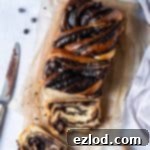
Print
Vegan Chocolate Babka
Ingredients
For the Enriched Vegan Dough:
- 300 g (approximately 2 ½ cups) plain (all-purpose) flour or strong white bread flour plus a little extra for dusting the work surface as needed
- 40 g (3 Tablespoons) caster (superfine) sugar
- 7 g (2 ¼ teaspoons) instant/fast action yeast (no need to activate)
- ½ teaspoon fine sea salt
- 180 ml (¾ cup) unsweetened non-dairy milk (soy milk recommended for richness) ensure it is lukewarm (approx. 37-40°C / 98-105°F)
- 80 g (⅓ cup) good quality vegan butter or baking margarine softened to room temperature
For the Decadent Chocolate Filling:
- 60 g (¼ cup) vegan butter or baking margarine
- 60 g (2 oz) good quality dark chocolate finely chopped, ensuring it’s vegan-friendly
- 20 g (2 Tablespoons) unsweetened cocoa powder
- 30 g (2 ½ Tbsp) light brown soft sugar
- ¼ teaspoon ground cinnamon (optional, but highly recommended for depth of flavor)
- pinch of fine sea salt
- 100 g (3 ½ oz) additional chocolate chips, chopped dark chocolate, or toasted pecans (for sprinkling over the filling)
For the Moistening Sugar Syrup:
- 60 g (¼ cup + 1 Tablespoon) granulated sugar
- 60 ml (¼ cup) water
Instructions
-
For optimal flavor development and easier handling, it is highly recommended to start preparing your babka dough the day before you plan to bake. In a large mixing bowl or the bowl of your stand mixer fitted with a dough hook, combine the flour, caster sugar, instant/fast-action yeast, and salt. Mix these dry ingredients thoroughly to ensure they are well distributed.
-
Gradually add the lukewarm non-dairy milk to the dry ingredients. Mix until a shaggy, rough dough forms. Continue to knead this dough until it comes together into a cohesive, relatively smooth ball.
-
Now, add the softened vegan butter, piece by piece, into the dough. Continue kneading the mixture diligently. Initially, the dough may appear greasy and somewhat messy as the butter incorporates, but be patient and keep kneading. I assure you, the butter will eventually blend in completely, and the dough will transform into a beautifully smooth, elastic, and unified mass.
-
Once the vegan butter is fully incorporated, your dough should look smooth, feel silky to the touch, and cleanly pull away from the sides of the bowl. It should still be soft and have a slight stickiness. If, however, it appears excessively wet, you may knead in a tiny bit more flour, adding it a teaspoon at a time. Exercise caution not to add too much flour, as this can lead to a dry babka.
-
Transfer the kneaded dough to a lightly oiled bowl, turning it once to coat. Cover the bowl loosely with plastic wrap or a damp kitchen towel. Allow the dough to rise at a warm room temperature for about an hour, or until it has nearly doubled in size. Following this initial rise, place the covered bowl in the refrigerator to continue rising slowly overnight (for at least 8-12 hours).
-
On the baking day, remove the dough from the refrigerator. Set it aside at room temperature for 30-60 minutes to allow it to warm up slightly and become more pliable while you prepare the chocolate filling.
-
For the filling, place the vegan butter, finely chopped dark chocolate, sugar, cocoa powder, optional cinnamon, and a pinch of salt in a small saucepan over very low heat. Stir continuously until all ingredients have melted into a smooth, glossy mixture. Remove from heat and allow it to cool for approximately 20 minutes. It should thicken to a spreadable consistency; if it becomes too firm, gently rewarm it for a moment or two until it’s easily spreadable again.
-
Gently punch down the dough to release the air. On a lightly floured surface, roll the dough out into a uniform rectangle measuring roughly 30x40cm (11×15 inches).
-
Evenly spread the cooled chocolate filling over the entire surface of the dough, leaving a narrow 1cm (½ inch) border clean around the edges. Sprinkle your additional chocolate chips, chopped dark chocolate, or pecans over the filling and gently press them in to adhere.
-
Starting from one of the long edges, carefully roll the dough up tightly into a firm sausage shape. Once rolled, use a very sharp knife to slice the sausage in half lengthwise, exposing the beautiful swirls of chocolate filling.
-
With the two halves of the dough, twist them together to form an intricate braid, ensuring the cut sides (with the filling) are mostly facing upwards to maximize the swirl effect. Grease an approximate 11.5 x 21.5 cm (4.5 x 8.5 inch) 2lb loaf tin and line it with baking parchment, leaving some overhang on the long sides. Carefully place the braided babka into the prepared loaf tin, gently adjusting it to fit if needed.
-
Loosely cover the tin with plastic wrap or a clean kitchen towel and set it aside in a warm spot for its second rise. Allow it to rise until it has visibly doubled in size, which should take approximately 1 ½ – 2 hours, depending on the warmth of your room. It is ready for baking when it looks puffy, and a gentle press on the exposed dough with your finger leaves a small indentation that slowly springs back, but not completely. If it springs back too quickly, it needs more time.
-
Once the babka is nearing the end of its second rise, preheat your oven to 180°C (160°C fan/350°F/gas mark 4).
-
Bake the babka in the preheated oven for about 40-50 minutes, or until it achieves a deep, rich golden-brown color on top. To confirm it’s cooked through, insert a probe thermometer into the center of the loaf; the internal temperature should reach at least 90°C (195°F).
-
While your babka is baking, prepare the simple sugar syrup. Combine the granulated sugar and water in a small saucepan and place it over a medium heat. Stir continuously until the sugar has fully dissolved and the mixture comes to a gentle simmer. Remove the syrup from the heat and set it aside.
-
As soon as the babka is removed from the oven, immediately and generously brush the entire top surface with the warm sugar syrup. Continue brushing until you have used all of the syrup, ensuring maximum absorption and a beautiful sheen.
-
Allow the babka to cool in its tin for 15-20 minutes. This allows the hot bread to continue absorbing the syrup and set. After this time, carefully lift it out of the tin using the parchment paper overhang and transfer it to a wire rack to cool completely before attempting to slice and serve. Slicing while warm can lead to a dense or gummy texture.
Notes
- For the absolute best baking results, meticulous adherence to the recipe is key. I consistently recommend using a digital scale for gram measurements over cup conversions. The inherent inaccuracy of cup measurements can significantly impact the outcome of baked goods, and I cannot guarantee optimal results if they are used.
- You have flexibility with your choice of flour. Both plain (all-purpose) flour and white bread flour will yield delicious babka. Using bread flour will impart a slightly chewier texture to the finished babka, while plain flour will result in a more tender crumb. A combination of the two can also be used for a balanced result.
- The sugar syrup is not merely for aesthetics; it is crucial for maintaining the babka’s delightful moisture and keeping it fresh for several days. Do not be tempted to omit this step! It may appear to be a substantial amount of liquid, but trust the process and ensure you use all of it.
- To confidently ascertain if your babka is thoroughly cooked in the middle, a probe thermometer is an indispensable tool. Given the significant variations between ovens, providing a universal baking time is impossible. The babka is perfectly done when its internal temperature reaches 90°C (195°F).
- I understand the intense desire to slice into a warm, fragrant babka, but it is vital to allow it to cool completely before cutting. The bread continues to bake internally as it cools, and slicing it prematurely can lead to a dense, gummy, or undesirable texture. Patience will be rewarded with the perfect babka crumb.
